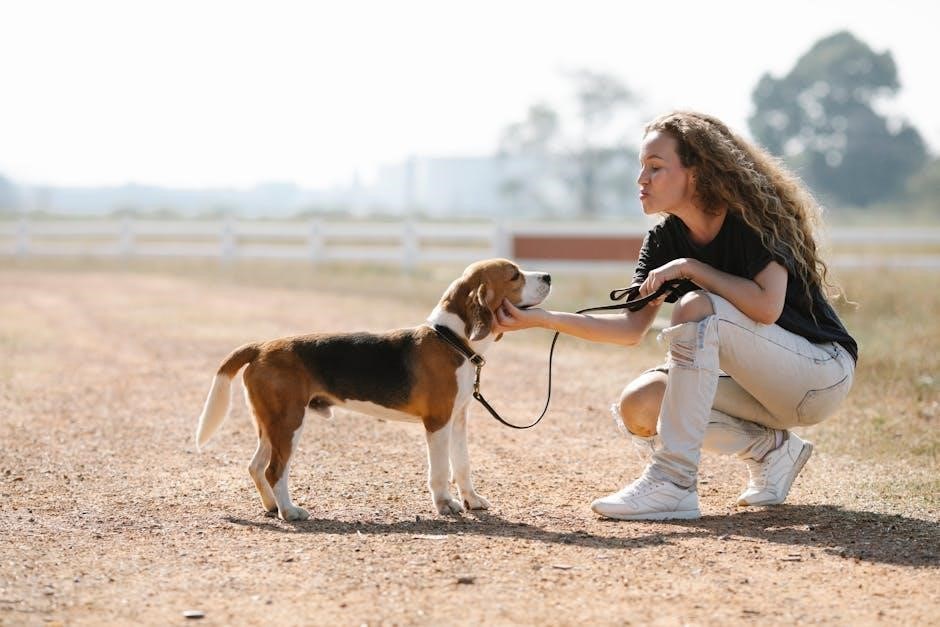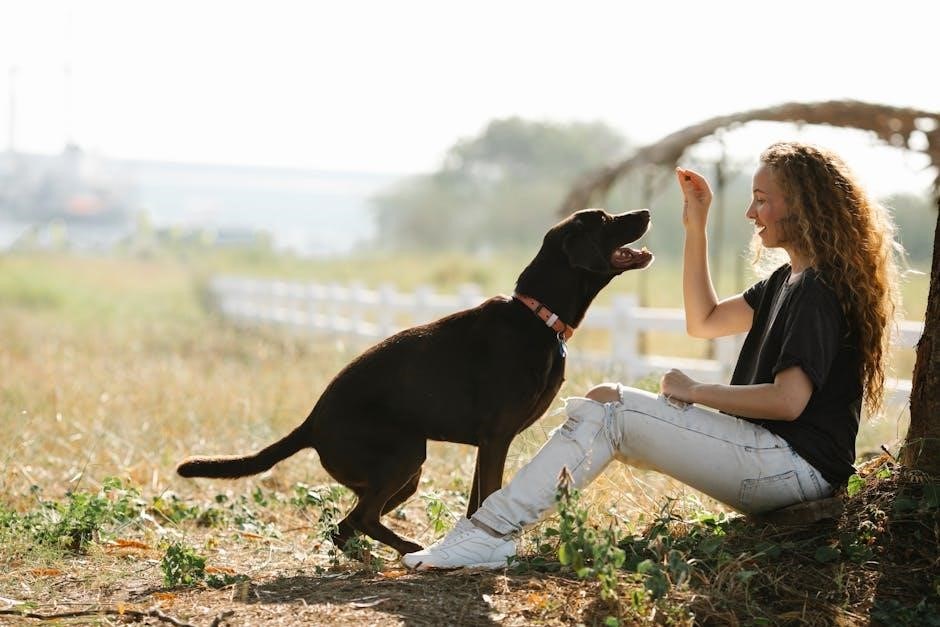Welcome to the comprehensive guide for your dog training collar. This manual ensures safe and effective use‚ helping you understand proper techniques and device operation for optimal results.
1.1 What is a Training Collar?
A training collar is an electronic device designed to assist in modifying a dog’s behavior through controlled stimulation. It typically consists of a receiver collar worn by the dog and a remote control for the owner. The collar delivers mild static‚ vibration‚ or tone corrections to refocus the dog during training. It is not a punishment tool but a means to communicate consistently and effectively. Proper use ensures safety and effectiveness‚ making it a popular choice for obedience training and addressing misbehaviors. Always follow the manual’s guidelines to avoid misuse and ensure the dog’s comfort and well-being.
1.2 Purpose of the Manual
This manual serves as a comprehensive guide to help you understand and use your dog training collar effectively; It provides detailed instructions on safety precautions‚ proper fitting‚ and operating procedures to ensure both you and your dog have a positive experience. The manual also covers troubleshooting common issues and offers training techniques to maximize the collar’s effectiveness. By following the guidelines outlined‚ you can safely and efficiently train your dog‚ addressing obedience commands and correcting unwanted behaviors. This resource is designed to empower you with the knowledge needed to use the collar responsibly and achieve the best possible results for your dog’s training journey.

Safety Precautions
Always follow guidelines to ensure safe use of the training collar. Avoid prolonged wear and keep it out of children’s reach to prevent accidents or injuries.
2.1 Proper Fitting and Usage
Proper fitting is essential for your dog’s comfort and safety. Ensure the collar is snug but not too tight‚ allowing one finger to fit between the collar and your dog’s neck. Avoid leaving the collar on for more than 12 hours a day and reposition it every 1-2 hours to prevent skin irritation. Never use the collar as a leash or tie-out‚ and ensure it is worn correctly to avoid misactivation. Regularly check the fit as your dog grows or sheds. Follow the manual’s guidelines to ensure proper contact and prevent excessive pressure. This ensures effective training and your dog’s well-being.
2.2 Usage Limits and Guidelines
To ensure safe and effective use‚ adhere to specific guidelines. Avoid leaving the collar on your dog for more than 12 hours per day‚ as prolonged wear can cause discomfort. Reposition the collar every 1-2 hours to prevent skin irritation. The collar should not be worn too tightly; it should fit snugly but allow space for one finger between the collar and your dog’s neck. Never use the collar as a leash or tie-out‚ as this can lead to improper activation. Proper wear is crucial to avoid misactivation and ensure your dog’s safety. Always follow the manual’s instructions for fitting and usage to prevent potential harm.
2.3 Keeping Out of Reach of Children
The training collar is not a toy and should be kept out of children’s reach to avoid accidental activation or misuse. Children may unintentionally harm your dog by pressing buttons or misusing the device. Store the collar and remote control in a secure location when not in use. Ensure that only adults operate the collar to prevent improper use. Teach children to avoid handling the collar or touching the dog while it is wearing the device. Failure to follow these guidelines may result in unintended stimulation or harm to your pet. Always prioritize your dog’s safety by keeping the collar inaccessible to minors.
Operating Guide
This section provides step-by-step instructions for charging‚ pairing‚ and adjusting settings on your training collar. Follow these guidelines to ensure safe and effective operation.
3.1 Charging the Collar
To ensure optimal performance‚ charge your dog training collar regularly. Use the provided USB charger and avoid overcharging‚ as this may reduce battery life. The collar typically takes 2-3 hours to fully charge. A full charge provides up to 10 days of use. Always monitor the battery level indicator and recharge when it falls below 20%. Proper charging habits will extend the lifespan of your device and ensure consistent operation during training sessions.
3.2 Pairing the Remote and Collar
To pair the remote and collar‚ ensure both devices are turned on. Locate the pairing button on the remote and the collar. Press and hold the pairing button on the collar until the LED light flashes. Simultaneously‚ press the pairing button on the remote for 3-5 seconds. The LED light will stop flashing once paired. This process ensures a secure connection between the remote and collar. If pairing fails‚ restart both devices and repeat the process. Once paired‚ the remote will control the collar effectively‚ allowing you to adjust settings and deliver commands seamlessly during training sessions;

3.3 Adjusting Settings for Your Dog
Adjusting the settings on your dog training collar is crucial for safe and effective training. Begin by turning on the collar and ensuring it is properly fitted. Use the remote to test the stimulation levels‚ starting from the lowest setting. Observe your dog’s reaction to determine the appropriate level. The collar should fit snugly but not too tight; ensure it allows for one finger to fit between the collar and your dog’s neck. Regularly check and adjust the fit to prevent discomfort. For optimal performance‚ reposition the collar every 1-2 hours. Always refer to the manual for specific guidance on adjusting settings for your dog’s size and breed.

Types of Stimulation Modes
This section explores the various stimulation modes available‚ including static stimulation‚ vibration‚ and tone modes‚ each designed for different training needs and dog temperaments.
4.1 Static Stimulation
Static stimulation is a common feature in training collars‚ delivering a mild electrical pulse to get your dog’s attention; It is adjustable‚ with levels ranging from low to high‚ allowing customization based on your dog’s sensitivity. Proper use involves starting at the lowest setting and gradually increasing if necessary. Always ensure the collar is fitted correctly to avoid discomfort. Static stimulation should be used sparingly and in conjunction with positive reinforcement for effective training. Avoid overuse‚ as it may lead to stress. This mode is particularly useful for correcting misbehaviors and reinforcing basic commands. Always refer to the manual for specific guidance on using static stimulation safely and effectively.

4.2 Vibration and Tone Modes
Vibration and tone modes offer humane alternatives to static stimulation‚ providing non-invasive ways to capture your dog’s attention. Vibration mode emits a gentle buzz‚ ideal for sensitive dogs or environments where tone may be distracting. Tone mode uses a distinct auditory cue‚ such as a beep‚ to signal commands. Both modes are highly effective for basic obedience training and correcting misbehaviors. They are particularly useful in noisy settings where verbal commands may not be heard. Consistency is key when using these modes‚ as they rely on your dog associating the stimulus with desired actions. Always use vibration or tone in conjunction with positive reinforcement for the best results‚ as outlined in the manual.
Training Techniques
Effective training techniques involve consistency‚ positive reinforcement‚ and clear communication. Use the collar to reinforce commands‚ correct misbehaviors‚ and encourage desired actions‚ ensuring a well-behaved and responsive dog.
5.1 Basic Obedience Commands
Mastering basic obedience commands is essential for effective dog training. Commands like “sit‚” “stay‚” “come‚” and “heel” form the foundation of a well-behaved dog. Use the training collar to reinforce these commands by associating them with consistent cues and rewards. Start with short sessions‚ ensuring your dog understands each command before moving on. Positive reinforcement‚ such as treats or praise‚ should follow correct responses. The collar can help redirect your dog’s attention and encourage prompt reactions. Always begin with the lowest stimulation level and gradually increase as needed. Consistency and clear communication are key to successful training. Consult the manual for specific techniques tailored to your dog’s needs.
5.2 Correcting Misbehaviors
Correcting misbehaviors effectively requires consistency and clear communication. Use the training collar to address unwanted actions like jumping‚ barking‚ or pulling on the leash. Start with the lowest stimulation level to get your dog’s attention‚ then redirect their focus to the desired behavior. Combine the collar’s cues with positive reinforcement‚ such as treats or praise‚ to reinforce good behavior. Avoid overuse‚ as this can lead to confusion or stress. Consistency is key—ensure all family members use the same commands and techniques. The collar is a tool to guide‚ not punish‚ so always prioritize your dog’s comfort and well-being. Consult the manual for tailored strategies to address specific misbehaviors effectively.

Choosing the Right Collar
Selecting the right collar involves considering your dog’s size‚ breed‚ and training needs. Ensure proper fit and comfort to avoid discomfort or skin irritation. Always follow manual guidelines for the best results.
6.1 Factors to Consider
When selecting a training collar‚ consider your dog’s size‚ weight‚ and breed to ensure proper fit and comfort. The collar’s stimulation type‚ such as static‚ vibration‚ or tone‚ should align with your dog’s temperament. Battery life and charging options are also crucial for convenience. Additionally‚ check for adjustable settings to customize the stimulation levels according to your dog’s sensitivity. Durability and water resistance are important if your dog is active or exposed to outdoor conditions. Always refer to the manual for specific product features and guidelines to make an informed decision that suits your training needs and ensures your dog’s safety and comfort.

6.2 Sizing and Breed Appropriateness
Proper sizing is essential for your dog’s comfort and the collar’s effectiveness. Ensure the collar fits snugly but not too tightly‚ allowing room for two fingers between the collar and your dog’s neck. Breed-specific considerations are crucial‚ as smaller breeds may require slimmer‚ lighter collars‚ while larger breeds need more robust designs. Always refer to the product’s size chart in the manual to match your dog’s measurements. Avoid using a collar designed for a larger dog on a smaller breed‚ as it may cause discomfort or ineffective stimulation. Regularly check and adjust the fit as your dog grows or gains/loses weight to maintain optimal performance and safety.
Maintenance and Care
Regularly clean the collar with a soft cloth and mild soap to prevent dirt buildup. Avoid harsh chemicals that may damage the materials. Store the collar in a dry place when not in use. Check and replace the battery contacts periodically to ensure proper functionality. Reposition the collar every few hours to prevent skin irritation. Follow these care tips to extend the lifespan of your training collar and ensure your dog’s comfort and safety.
7.1 Cleaning the Collar
To maintain your dog training collar’s functionality and hygiene‚ clean it regularly. Use a soft‚ damp cloth to wipe down the collar‚ avoiding harsh chemicals or abrasive materials. Gently remove dirt or debris from the contact points and straps. Do not submerge the collar in water‚ as this may damage the electronic components. After cleaning‚ allow the collar to air dry completely before use. Regular cleaning prevents skin irritation and ensures proper stimulation. Always store the collar in a dry place when not in use to maintain its condition and longevity. Proper care will ensure your training collar remains effective and comfortable for your dog.
7.2 Battery Maintenance Tips
Proper battery care is essential for the longevity and performance of your dog training collar. Always charge the collar using the provided charger to avoid damage. Avoid overcharging‚ as this can reduce battery life. When not in use‚ store the battery in a cool‚ dry place. If the collar will be unused for an extended period‚ charge the battery to 50% and check it every few months. Clean the battery contacts regularly with a soft cloth to ensure good connectivity. Replace the battery if it no longer holds a charge‚ even after proper charging. Follow these tips to maintain optimal performance and extend the life of your training collar.

Troubleshooting Common Issues
If the collar isn’t responding‚ check the battery level and ensure proper pairing. Restart the device and verify connectivity. Consult the manual for detailed solutions to common problems.
8.1 Device Not Responding
If the training collar or remote is not responding‚ first ensure the battery is fully charged. Turn the device off and on again to reset it. Check that the remote and collar are properly paired according to the manual. Verify that the collar is turned on and set to the correct mode. If issues persist‚ consult the troubleshooting section for further guidance. Always refer to the user manual for detailed instructions on resolving connectivity or responsiveness problems.
8.2 Interference and Connectivity Problems
If you experience interference or connectivity issues with your training collar‚ ensure there are no physical obstructions between the remote and collar. Move away from other electronic devices that may cause interference. Check that the collar and remote are properly paired and that the battery levels are sufficient. Restart both devices and ensure the collar is fitted correctly on your dog. If problems persist‚ consult the troubleshooting section of the manual for additional solutions. Always follow the manufacturer’s guidelines to resolve connectivity issues effectively.
Legal Considerations
Ensure compliance with local laws regarding training collar use. Familiarize yourself with regulations to avoid legal issues and guarantee ethical‚ responsible use of the device.
9.1 Regulations on Collar Use
Check local laws regarding training collar use‚ as some jurisdictions ban specific types‚ such as choke or prong collars. Ensure compliance to avoid legal consequences. Certain regions may restrict electronic collar use without professional guidance. Always verify regulations before using the device‚ especially in areas with strict animal welfare laws. Some countries require certification or training for collar use. Stay informed about updates to ensure ethical and lawful use of the training collar. Consulting local authorities or animal welfare organizations can provide clarity. Adhere to all legal guidelines to promote responsible pet ownership and maintain compliance with regional regulations.
9.2 Compliance with Local Laws
Always verify and comply with local laws and regulations regarding the use of training collars. Some jurisdictions have banned specific types of collars‚ such as choke or prong collars‚ while others may restrict electronic collar use without professional certification; For example‚ cities like Toronto have implemented bans on certain training tools‚ requiring users to switch to alternative methods. Ensure you understand regional restrictions to avoid legal consequences. Consulting local animal welfare organizations or authorities can provide clarity. Stay updated on legal changes to maintain compliance and promote ethical pet ownership. Non-compliance may result in fines or legal action‚ emphasizing the importance of adhering to local regulations.
User Manual Overview
This manual provides detailed guidance on setup‚ operation‚ and training‚ ensuring you master your dog training collar’s functions and capabilities effectively and safely.
10.1 Navigating the PDF Manual
Welcome to the PDF manual for your dog training collar. This guide is designed to help you navigate and understand the product’s features‚ setup‚ and usage. The manual is organized into clear sections‚ starting with an introduction and moving through safety precautions‚ operating guides‚ and troubleshooting. Use the bookmarks panel in your PDF viewer to quickly jump to specific sections. The table of contents provides a detailed overview of each chapter. Key sections include Safety Precautions‚ Operating Guide‚ and Training Techniques. Familiarize yourself with these areas to ensure safe and effective use. For easy navigation‚ use the search function to locate specific topics or terms. Always refer to the manual for troubleshooting and maintenance tips to maximize your product’s performance and longevity.
10.2 Key Sections to Review

For optimal use of your dog training collar‚ review the following key sections in the manual. Start with the Safety Precautions to ensure proper usage and avoid potential risks. The Operating Guide provides step-by-step instructions for charging‚ pairing‚ and adjusting settings. Familiarize yourself with Training Techniques to effectively teach commands and correct behaviors. Additionally‚ the Troubleshooting section offers solutions for common issues‚ while Maintenance and Care details how to clean and maintain the collar. Don’t overlook the FAQs for answers to common questions. Reviewing these sections will enhance your understanding and ensure safe‚ effective use of the collar. Always prioritize compliance with local laws and regulations when using the device.

FAQs
Find answers to common questions about usage‚ addressing concerns‚ and clarifying myths about training collars in this section. Your satisfaction and your dog’s well-being are our priority.
11.1 Common Questions About Usage
How do I pair the remote and collar? Ensure both devices are turned on and follow the pairing instructions in the manual. Why isn’t my dog responding? Check the collar fit and ensure settings are appropriate for your dog’s size and temperament. Can I use the collar for puppies? Yes‚ but consult a professional to ensure safe and effective use. How long can the collar be worn? Avoid exceeding 12 hours daily and reposition every 1-2 hours for comfort. Are vibration and tone modes safe? Yes‚ they are gentle alternatives to static stimulation. Always refer to the manual for detailed guidance.
11.2 Addressing Concerns and Myths
Many users have concerns about the safety and ethics of using a training collar. Rest assured‚ when used correctly‚ these devices are safe and humane. A common myth is that collars cause pain‚ but they are designed to provide a mild‚ unpleasant sensation‚ not harm. Another concern is about dependency‚ but proper training should gradually reduce reliance on the collar. Some worry about long-term effects‚ but studies show no negative impact when used responsibly. Always follow the manual’s guidelines to ensure safe and effective use. If unsure‚ consult a professional trainer for personalized advice. Remember‚ the goal is to enhance communication with your dog‚ not to punish.
By following this manual‚ you’ve taken a significant step toward effective and responsible dog training. Remember‚ consistency and patience are key to achieving desired results. Always prioritize your dog’s safety and well-being by adhering to the guidelines provided. If questions arise‚ refer to the troubleshooting section or contact our support team. Proper use of the training collar enhances communication with your dog‚ fostering a stronger bond. Thank you for choosing this product‚ and we wish you and your dog a successful training journey. Together‚ you can achieve better behavior and a happier‚ healthier relationship.